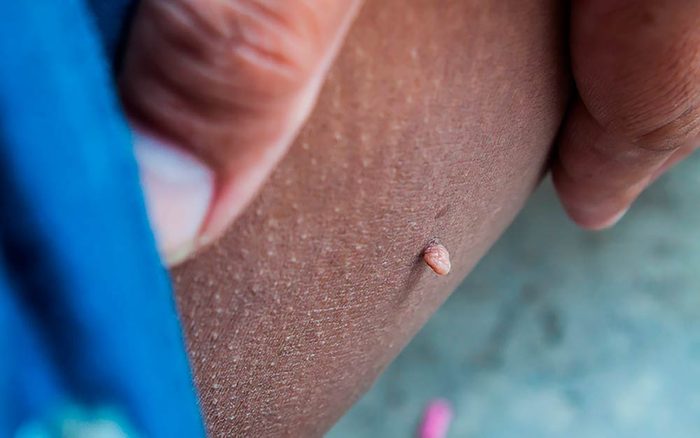How to Get Rid of Skin Tags, According to a Dermatologist
Updated: Jul. 27, 2022

They're generally harmless, harmless, but derms say there's a very good reason you shouldn't ignore them. Here’s what to know about skin tag removal.
Skin tag removal is pretty common—the National Library of Medicine estimates that up to 60 percent of us will get at least one of these fleshy little skin growths at least once in our lifetime. Skin tags (also called acrochordons) are technically tiny, benign tumors, but they’re generally not a cause for concern. Still, it’s worth checking in with your doctor if you notice them crop up. Skin tags could be a sign of diabetes, high blood pressure, elevated heart disease risk, and metabolic syndrome, according to research published in BMC Research Notes.
Most people will opt for skin tag removal simply because they don’t like their appearance or, depending on where they appear on your body, the hanging bits of skin can be irritating. Here’s what dermatologists want you to know if you’re looking to get rid of skin tags.
Stay on top of the latest in health and wellness trends with The Healthy @Reader’s Digest newsletter delivered to your inbox daily
What are skin tags?
Skin tags look like small bumps of tissue that extend out from your skin—typically thinner at the base and wider at the top, according to experts at the Cleveland Clinic. “They look like a little out-pouching of skin,” adds Jennifer Gordon, MD, a board-certified dermatologist at Westlake Dermatology in Austin, TX. “They have a fibrovascular stalk surrounded by flattened skin cells and like to occur in areas that rub—the neck, under the arms, in the groin, and around the eyes,” she explains. But they’re not one-size-fits-all: skin tags are often the same color as your skin but can appear darker or look like a raised mole. (Though if you are getting a mole removed, here’s what to expect.)
Skin tags may not signal cancer—but dermatologists urge you understand these surprising facts about skin cancer
Why do you get skin tags?
People prone to skin tags will most likely see them pop up later in life, though they can occur at all ages. Genetics probably plays a role in skin tag development, according to Dr. Gordon. But weight gain, pregnancy, and diabetes are also known to trigger these noncancerous skin growths, too. Friction can also cause skin tags to grow over time, which is why they’re most common in areas like the armpit, neck, and groin. However, Dr. Gordon says no one cause can be pinpointed in most cases. (But check out these scientific explanations for 25 other weird body reactions.)
Are skin tags dangerous?
In general, skin tags are harmless. “They can be seen in diabetes, so that is something to consider having checked if you suddenly see a lot of tags arise,” says Dr. Gordon. “Skin tags can become strangulated and painful, as well as infected at times. If this happens, removal is recommended and a visit to your dermatologist to make sure antibiotics are not needed,” she says.
How to get rid of skin tags
Skin tag removal isn’t something that should be done in your bathroom at home. Many people will look up how to get rid of skin tags on the Internet and try to do it themselves, but you should always go to a dermatologist to have them removed. People have used all kinds of crazy methods for skin tag removal on their own, says Anthony Rossi, MD, an assistant attending dermatologist at Memorial Sloan Kettering Cancer Center. He’s heard of people tying strings around them, burning them, trying to pick them off with their fingers, and even slamming books against them. “It’s wild what people will do,” he says. Check out more terrible skin-care advice dermatologists wish you’d stop following.
A dermatologist, on the other hand, can snip away skin tags quickly and cleanly. Sounds like you can learn how to get rid of skin tags yourself, right? Not so fast. “It’s like when people try to cut their own hair,” says Dr. Rossi. “It never goes the way they want it to.”
For one thing, dermatologists have sterile instruments, but using your own could lead to an infection. Plus, while derms can use local anesthesia and have supplies to stop the blood, you could bleed uncontrollably with at-home methods for skin tag removal.
Don’t trust drugstore remedies
Even over-the-counter medications claiming to dissolve the skin tags could be bad news, says Dr. Rossi. “You could burn the skin or make marks. There could be unintended consequences,” he says. If you hate the idea of anyone snipping your skin, ask a doctor to freeze or burn it instead.
But there’s an even bigger reason you should visit an expert. After dermatologists remove a growth, they’ll look at it under a microscope. “There are things that look like skin tags but are cancerous,” says Dr. Rossi. That doesn’t mean you should freak out if you do find a skin tag. Most will just be benign, but you won’t know for sure until you’ve asked. Plus, checking a skin tag is a “good excuse” to get your doctor to check the rest of your body for skin cancer and atypical or malignant growths, says Dr. Rossi. Before you start thinking you know how to be your own dermatologist, read up on these things you should never do to your skin.
Follow The Healthy on Facebook, Instagram, and Twitter for the latest health trends and updates. In the meantime, check out:
- A Dermatologist and Dietitian Just Listed the 5 Worst Foods That Age Skin Faster
- One Major Effect of Blue Light on Your Skin, Says Research
- 8 Vitamin C Serum Tricks Derms Say Will Give Your Skin the Greatest Results
- The 3-Step Skincare Process Derms Are Recommending This Summer—and 3 Products to Halt Until Fall

















